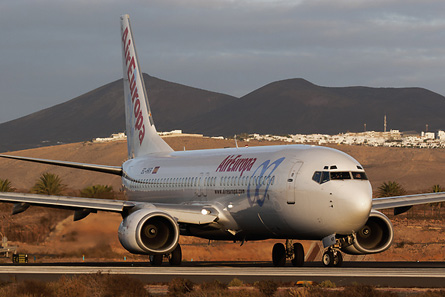Spanish investigators have found that an overbearing captain helped create the circumstances for an unstable approach, which led an Air Europa Boeing 737-800 to overrun at Lanzarote.
The aircraft overflew the Runway 21 threshold at 55m (180ft) at 175kt (324km/h), with the flaps deployed at just 25° owing to automated flap-loading limitations.
It travelled halfway along the runway - which was wet - before touching down some 1,300m beyond the threshold. While the brakes were applied immediately, thrust reversers were not activated for 13s, by which time the 737 was barely 200m from the end of the runway.
The aircraft, which had arrived from Glasgow, overran at 94m and crossed a 60m stopway before coming to a halt just a metre from the jet-blast barrier, next to the perimeter fence.
Spanish investigation agency CIAIAC discovered that the 737 was originally to land on Runway 03, and the flying first officer had programmed this descent into the flight management computer.
 |
|---|
© Adrian Jack/AirTeamImages.com Investigators have found that an overbearing captain helped create the circumstances for an unstable approach, which led an Air Europa Boeing 737-800 to overrun at Lanzarote on 31 October 2008 |
But the captain opted instead for a Runway 21 approach, without consulting the first officer, forcing him to prepare a different landing procedure without much time. The aircraft, at the time, was at 14,600ft (4,453m) and 56km (30.5nm) from the runway.
While the first officer tried, with difficulty, to reprogramme the flight computer, the captain prompted him to keep descending. "[The first officer's] lack of assertiveness to tell the captain that he did not agree with what he was being forced to do is undoubtedly a contributing factor to the genesis of the incident," said CIAIAC.
It said the captain "made every decision" but "at no time" asked the first officer's opinion. Despite being aware of the "worsening" situation, and "undoubtedly" noticing the inability of the first officer to cope after the runway switch, the captain did not touch the controls or the autopilot.
"During the approachthe first officer was at times overwhelmed by work, while the captain limited himself to telling the first officer that he had to descend more, without actually intervening directly," said CIAIAC's report on the 31 October 2008 event.
While the captain had 8,388h on type (more than 10 times that of the first officer), CIAIAC said he decided to continue the approach "in spite of the presence of a multitude of indications that suggested or required that the manoeuvre be stopped".
These indications included the aircraft's high energy state as well as repeated alerts from the enhanced ground-proximity warning system, over a 28s period, as it descended below 900ft.
Although the aircraft sustained minor tyre damage in the incident, none of the 80 occupants was injured.
Source: Flight International























